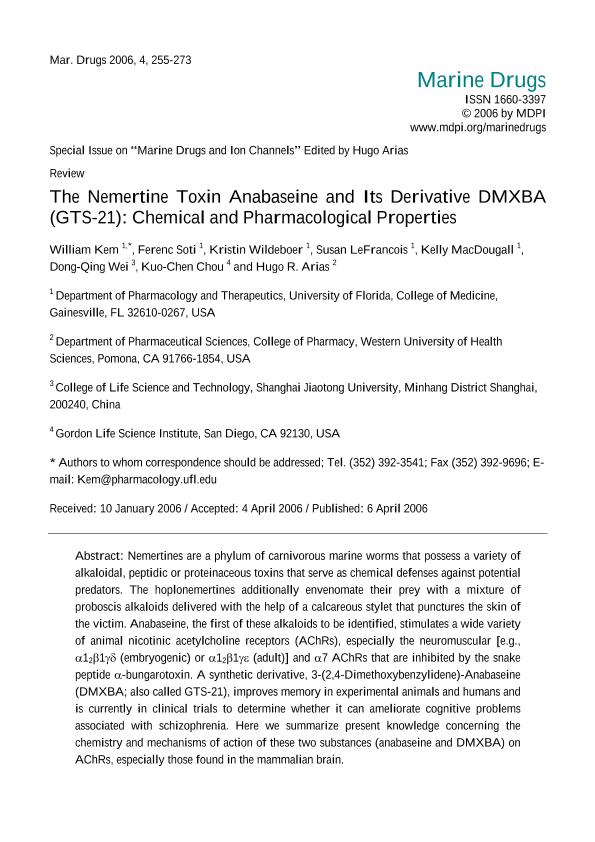Artículo
The Nemertine Toxin Anabaseine and Its Derivative DMXBA (GTS-21): Chemical and Pharmacological Properties
Kem, William; Soti, Ferenc; Wildeboer, Kristin; LeFrancois, Susan; MacDougall, Kelly; Wei, Dong Qing; Chou, Kuo Chen; Arias, Hugo Rubén

Fecha de publicación:
04/2006
Editorial:
Molecular Diversity Preservation International
Revista:
Marine Drugs
ISSN:
1660-3397
Idioma:
Inglés
Tipo de recurso:
Artículo publicado
Clasificación temática:
Resumen
Nemertines are a phylum of carnivorous marine worms that possess a variety of alkaloidal, peptidic or proteinaceous toxins that serve as chemical defenses against potential predators. The hoplonemertines additionally envenomate their prey with a mixture of proboscis alkaloids delivered with the help of a calcareous stylet that punctures the skin of the victim. Anabaseine, the first of these alkaloids to be identified, stimulates a wide variety of animal nicotinic acetylcholine receptors (AChRs), especially the neuromuscular [e.g., α1 2β1γδ (embryogenic) or α1 2β1γε (adult)] and α7 AChRs that are inhibited by the snake peptide α-bungarotoxin. A synthetic derivative, 3-(2,4-Dimethoxybenzylidene)-Anabaseine (DMXBA; also called GTS-21), improves memory in experimental animals and humans and is currently in clinical trials to determine whether it can ameliorate cognitive problems associated with schizophrenia. Here we summarize present knowledge concerning the chemistry and mechanisms of action of these two substances (anabaseine and DMXBA) on AChRs, especially those found in the mammalian brain.
Palabras clave:
ANABASEINE
,
COGNITION
,
DMXBA
,
GTS-21
,
NEMERTINE
,
NICOTINIC RECEPTORS
Archivos asociados
Licencia
Identificadores
Colecciones
Articulos(INMABB)
Articulos de INST.DE MATEMATICA BAHIA BLANCA (I)
Articulos de INST.DE MATEMATICA BAHIA BLANCA (I)
Citación
Kem, William; Soti, Ferenc; Wildeboer, Kristin; LeFrancois, Susan; MacDougall, Kelly; et al.; The Nemertine Toxin Anabaseine and Its Derivative DMXBA (GTS-21): Chemical and Pharmacological Properties; Molecular Diversity Preservation International; Marine Drugs; 4; 3; 4-2006; 255-273
Compartir
Altmétricas



